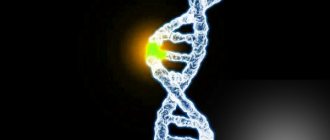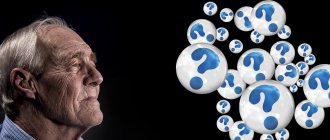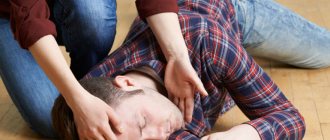Article on the topic
Why do people talk in their sleep?
Indeed, there is a disease in which there is an irresistible desire to sleep, regardless of where the person is. This is narcolepsy - from the Greek “narkē” - numbness and “lēpsis” - sleep, in another way - Gelineau’s disease, or paroxysms of irresistible drowsiness. This disease is quite rare, usually developing between the ages of 20 and 50, more often in men. The prevalence of narcolepsy in developed countries is 20–40 cases per 100,000 people.
Strange story
Of course, not all sleepiness is narcolepsy. There are times in any person's life when the need for sleep increases. Here, for example, is the story that happened to the author of these lines in his youth.
After two unsuccessful attempts to become a student and service in the army, I entered the university. The day before I had an affair with one girl, we were going to get married, but then we broke up. I was very painfully experiencing the breakup and then, while studying in my first year, I suddenly felt a strange state...
I was attacked by a stupefying drowsiness, I could not stay awake for more than thirty to forty minutes, a maximum of an hour, then I inevitably fell asleep. Moreover, it came at the most inopportune time, in the most inopportune place: on the subway, at a lecture. To prevent this from happening, I decided to get enough sleep: during recess I would find an empty classroom and, sitting down on three pushed-together chairs, instantly fell asleep. Luckily, I only needed 5-10 minutes to fall asleep. Then I got up, invigorated, and could exist normally for about another hour. Then something like dizziness began again and it was necessary to urgently take a horizontal position. This state lasted two or three days and passed.
Ten years later, these attacks of drowsiness were repeated after another stress - the death of my father. On weekends I slept around the clock. I fell asleep on the train and in the subway. So, maybe this is narcolepsy?
At the Center for Somnological Research of the Ministry of Health and Social Development of the Russian Federation, Professor Yakov Iosifovich Levin explained to me that attacks of drowsiness recurring once every ten years are unlikely to be a disease. Normal stress from prolonged overexertion manifests itself differently in different people. Some cannot fall asleep, others, on the contrary, sleep like marmots, and this helps them recover and come to their senses. In patients with narcolepsy, attacks are much more severe and occur more often.
Self-help for narcolepsy
In parallel with drug therapy, it is important to normalize night sleep. To eliminate insomnia, the patient is prescribed hypnotics. But the patient himself can help him fall asleep better in the evenings. It is necessary to create suitable conditions in the room: complete darkness, silence, absence of any irritants.
It is recommended to purchase a comfortable mattress and natural bed linen. A warm bath and meditation are very relaxing. Follow your doctor's recommendations and these tips, and the disease will not be a global problem that makes it impossible to lead a normal lifestyle!
Phase confusion
Scientists equate the sensations of a patient with narcolepsy to the state of a person deprived of sleep for two days. Despite their excruciating sleepiness, narcoleptics often cannot fall asleep properly at night.
With this disease, there are repeated attacks of sleep, which are no different from normal, but occur in an inadequate situation. If you watched the movie “Oklahoma As It Is,” then you probably remember how its hero fell anywhere due to bouts of drowsiness.
Perhaps the internal cause of narcolepsy is disintegration syndrome, the untimely onset of stages of sleep, especially fast sleep. Let us remember that sleep is divided into phases. “Slow sleep” consists of four stages, levels. The first is the most superficial, the last is the deepest. The changes that occur during each stage or during the transition from one to another can be traced on the encephalogram.
During sleep, the encephalogram shows the presence of faster waves. When we fall asleep, the pattern changes, as if calm sets in. As sleep deepens, the waves smooth out even more, and “delta sleep” begins.
After an hour and a half, dreams arise, and the encephalogram again resembles the curve of a waking person. At this time, the sleeper can observe eye movement under closed eyelids - this is the “REM sleep phase.”
Patients with narcolepsy fall asleep in less than 10 minutes - the REM sleep phase begins early in them, but the deep, delta sleep phase is completely absent. That is, they sleep superficially, and there are many night awakenings.
Symptoms of Narcolepsy
At first glance, the symptoms of narcolepsy are quite simple and even obvious.
The main symptoms include:
- drowsiness;
- fatigue;
- absent-mindedness;
- irresistible craving for sleep.
Such symptoms can also appear in absolutely healthy people, if there are specific reasons for this.
For example, when doing monotonous work or listening to monotonous music or long lectures. In this case, the lecturer’s speaking style also plays an important role - the more monotonous, slow and quiet the voice, the faster the listeners will lose attention and begin to fall asleep. The same thing can be a result of not getting enough sleep at night. But in the case when a person really suffers from such disorders, sleep attacks overtake him in almost any activity and in any place. A person can “switch off” even when performing quite active physical or mental work. In such cases, one can almost certainly establish that a person has narcolepsy.
But all these are only visible reasons, visible to the prying eye. In principle, if only the above symptoms are manifested, perhaps this is really nothing more than severe overwork, which can be treated with full and long rest.
In the case when the problem really occurs, the person periodically experiences either hallucinations or vivid dreams, which are replaced by insomnia. With such symptoms, the boundaries of reality can become blurred, so you should immediately consult a doctor. If the patient does not realize this himself, relatives should help him.
First symptoms
In addition to severe daytime sleepiness, the symptoms of the disease are as follows.
● Cataplexy is an attack of sudden general weakness against the background of any strong emotions, no matter positive or negative, laughter, crying or amazement. The attack can develop so quickly that the patient is at risk of falling and getting injured. Its duration ranges from several seconds to several minutes. This is usually followed by falling asleep.
● Waking dreams are vivid visions similar to a dream. They are usually accompanied by anxiety. Visions occur either at the moment of falling asleep or during awakening. Patients may see objects or people, hear music or voices.
● Sleep paralysis is complete immobility that lasts from a few seconds to several minutes after waking up. The person is fully conscious, able to assess the situation, but unable to move. Sleep paralysis is most common in the morning, but can occur at other times. Over time, other symptoms may appear.
You can suspect the disease yourself by daytime sleepiness, but only a specialist in the field of sleep medicine can make an accurate diagnosis after conducting diagnostic studies: polysomnography, encephalography, and so on. Unfortunately, it is not always possible to diagnose the disease quickly, because various sleep disorders are common, so many doctors do not even think about the rare disease.
It is not yet possible to completely get rid of narcolepsy, but symptomatic treatment of the disease can significantly improve the quality of life. Your doctor may prescribe medications to help relieve daytime sleepiness and improve nighttime sleep. Medications with a psychostimulating effect are effective - antidepressants of various groups.
Gelineau's mysterious disease
What kind of strange disease is narcolepsy, and what causes a person to sleep while walking? The term comes from two Greek words: “narkosis” - torpor and “lepsis” - to possess. The prerequisites for the development of pathology have not been fully elucidated.
It is important to know! This is a fairly rare disease, affecting no more than 20 people per 100,000 population. Another name is Gelineau's disease, named after the French scientist who first described this condition.
Nature of the disease and risk groups
Modern scientists agree that one of the reasons is a violation of the synthesis of the hormone orexin. All patients with narcolepsy had a deficiency of this substance in the spinal fluid. It is responsible for switching the nervous system from wakefulness to sleep. The following factors can disrupt the production and metabolism of the neurotransmitter:
- intrauterine fetal malformations associated with genetic mutations;
- heredity;
- malfunctions of a woman’s endocrine system during pregnancy, especially dysfunction of the thyroid gland and their consequences - hyper- and hypothyroidism;
- traumatic brain injuries;
- overwork - psychological and physical;
- infectious processes in the brain;
- diabetes;
- diseases of the thyroid gland (87% of those suffering from hypersomnia have hypothyroidism).
However, these factors will not necessarily lead to Gelineau's disease. As a rule, in people who come to the doctor with a complaint about falling asleep while walking, another cause of narcolepsy is autoimmune disorders - in the blood of patients, the content of pathological T-lymphocytes exceeds the norm and differs significantly from the analysis values of a healthy person.
There are 4 forms of the disease:
- The primary one, as a rule, has congenital causes. Manifest age is from 15 to 30 years. This is the name of the time during which the disease is most pronounced.
- The secondary form is the consequences of diseases of the brain and its membranes.
- Paroxysal occurs against the background of epileptic lesions.
- The form without catalepsy is a rare variety; it occurs without muscle weakening, and sometimes without REM sleep.
At risk are pregnant women with endocrine system problems or poor lifestyle; people with a family history of the disease; patients with epilepsy or various brain lesions.
Symptoms of Narcolepsy
The most important sign by which a diagnosis of “narcoleptic disease” is made is severe daytime sleepiness, it is almost impossible to resist it, it inevitably leads to falling asleep anywhere. Most of all, this symptom manifests itself when performing monotonous activities, for example, when studying while listening to lectures. However, active exercise is not an obstacle - an attack occurs in any environment, a person can “fall asleep on the go” anywhere. These manifestations are observed more often in the first half of the day; towards the evening, the narcoleptic person’s state of lethargy and weakness disappears.
As soon as the patient falls into hypnotic sleep, he immediately begins to dream. This period lasts from 5 minutes to three hours. You can wake up a person suffering from Gelineau's disease in the same way as a normal person who has fallen asleep. After waking up, he feels more cheerful, but this feeling is short-lived and soon gives way to weakness. There are several such episodes per day.
Another characteristic sign is that it is very difficult for a person to fall asleep in the evening. Night sleep is intermittent, shallow, in the morning the patient always feels tired, as if he never went to bed.
Sometimes there are hallucinations - dreams with open eyes. This condition is typical for children; it is rare in adults.
Catalepsy before falling asleep is observed in ¾ of all patients. It manifests itself in weakening of skeletal muscles while maintaining consciousness. A person can fall, but he understands and feels everything. The opposite effect also happens - the patient falls asleep while moving, for example, while walking, without realizing what is happening. This state lasts for several minutes, after which awakening occurs.
A quarter of narcoleptics experience sleep paralysis - muscle numbness in the first minutes after waking up and sometimes before falling asleep. The patient wants to move his limbs or turn his head, but he is unable to do so.
In children, the symptoms are similar, but are not immediately noticed by parents, who mistake the signs of Gelineau’s disease for characteristics of an early age. The child may be lethargic, lethargic, absent-minded, and falls asleep quickly, especially after eating. It is extremely difficult to wake him up in the morning; in response to such attempts, the baby becomes capricious or even throws a tantrum. At night, his sleep is restless, he can twitch, make sounds, and often wake up (several times).
It is important to know! An important sign of narcolepsy in childhood is that before falling asleep, the child falls in a clear consciousness (catalepsy).
there is hope
Of course, this is a disease that cannot be ignored. Those who suffer from it should choose their profession with special care. They are contraindicated from working at heights, with moving mechanisms, requiring increased attention, or night shifts. During an exacerbation, it is necessary to have the opportunity for short sleep breaks of 15–20 minutes at 2–3 hour intervals during the day.
At the beginning of this century, a scientific discovery was made that finally helped to understand the nature of this mysterious disease. Researchers have found that patients with narcolepsy lack orexin, a special hormone found in the brain. American scientists have developed a nasal spray that contains the hormone orexin A. During experiments (the drug was tested on monkeys), it turned out that after its injection the animals felt great, even if they did not sleep enough. Naturally, the development immediately aroused interest among the military. There is also hope for patients with narcolepsy: perhaps the day is not far off when this disease will no longer be incurable.
Signs of the disease
There are two mandatory symptoms of narcolepsy:
- Falling asleep “on the go”, when a person suddenly falls asleep for no apparent reason. Most often this happens during monotonous work, but it is possible to completely unexpectedly fall asleep during a conversation, while walking, while watching a movie, or in any other situations. Such sleep usually lasts a few minutes, but in severe forms of narcolepsy it can last for hours.
- Sudden involuntary relaxation of all muscles of the body (cataplexy), which occurs at the moment when a person experiences vivid emotions (laughter, surprise, rage, vivid memories, anxiety, a certain period of sexual intercourse). Cataplexy (loss of muscle tone) is rarely the first symptom of narcolepsy, and much more often it develops over the years.
In the first case, inhibition captures the cerebral cortex, but does not reach the lower parts of the brain, so the person falls asleep, but immobility does not occur. So, if he falls asleep while walking, then in a sleeping state he can walk for another 1-2 minutes and then wake up.
In the second case, the opposite happens. With normally preserved consciousness, immobility occurs. The person’s muscles relax, he simply falls, but still manages to find a place to fall, for example, sits down on a chair.
These are not all the symptoms of narcolepsy; many patients experience the full range of possible symptoms, including:
- sudden falling asleep and cataplexy (discussed above);
- vivid dreams up to hallucinations that are observed when falling asleep or waking up;
- immediately after waking up, a person cannot move for several seconds (this condition is called sleep paralysis);
- there is an urgent need for daytime sleep.
In addition, due to the absence of the slow-wave (deep) sleep phase, it is not uncommon for patients with narcolepsy to sleep poorly at night, their sleep is shallow, and they often wake up.
Symptoms of narcolepsy can develop over many years or occur all at once. However, you should not assume that if you have the symptoms listed above, then you necessarily have narcolepsy. These manifestations are also signs of many other diseases, but most often they can simply be temporary disorders due to stress, chronic fatigue, lack of sleep, etc.
Interesting
It recently became known that Leonardo da Vinci suffered from narcolepsy. He developed an irresistible drowsiness after three years spent in the dungeon of the Doge's Palace. The great artist and thinker not only did not allow the disease to break him, but also learned to benefit from it for creativity. To prevent attacks from taking him by surprise, Leonardo invented a wheelchair that was always nearby, and there was also paper and a pencil nearby. As soon as the artist woke up, he immediately captured the visions that visited him during the attacks.
Important
Diagnosis by sleep pattern. Two tests are usually performed to confirm the diagnosis: polysomnography and the MSLT test.
For polysomnography, you must spend the night in a sleep laboratory. You will be asked to sleep in an environment as close to your usual environment as possible. Small electrodes will be attached to the skin using a sticky jelly-like substance. They record brain waves, muscle activity, heart rate and eye movements. The test is necessary to rule out other disorders that have similar symptoms.
The next day, the MSLT test is performed. During the daytime, with the same electrodes, you will be asked to sleep for 20 minutes four to five times at intervals of two hours. The MSLT test examines your sleep pattern. People with narcolepsy have a different sleep pattern from healthy people.
Treatment of narcolepsy
If you suspect a disease, you should consult a neurologist or neurosurgeon. After diagnosis, in the absence of other central nervous system pathologies, the patient is referred to a more specialized specialist - a somnologist. He is the one who treats narcolepsy.
Diagnostics
To identify the true cause of the disease, the following diagnostic measures are carried out:
- Dream recording method (polysomnography) - the patient must stay overnight in a medical facility, where the sequence of onset of sleep phases is examined using equipment.
- Quantitative assessment of daytime sleepiness (abbreviation in English - MSLT, literal translation - multiple sleep latency test) - a person falls asleep during the day for 20 minutes, during which time his brain signals are recorded. To exclude other diseases, testing is carried out 5 times a day.
- Magnetic resonance imaging scans the brain layer by layer and is currently the best method for diagnosing organs. Detects tumors and structural anomalies.
It is important to know! The distinctive and main symptom of narcolepsy is sleep phase disturbance. The patient experiences a lack of deep sleep, which is why he feels tired all the time.
This pathology is recorded using the instrumental diagnostic methods described above - polysomnography and MSLT.
The disease should be differentiated from other pathologies:
- Pickwickian syndrome. The main symptom of the disease is the same - an irresistible desire to sleep during the day and falling asleep while walking. However, this pathology is characterized by obesity of 3-5 degrees, as a result of which the diaphragm is located too high, causing oxygen starvation of the body and abnormal drowsiness. After the patient loses weight, all signs of the disease disappear.
- Kleine-Levin syndrome. Characteristic of young people, then symptoms regress. A person falls asleep in any environment, upon awakening he experiences attacks of enormous hunger and eats everything. Behavioral changes are also observed - aggression, hyperactivity, agitation after sleep.
- Lethargy. The patient falls asleep for a long time - from several hours to several weeks. In the comatose form, it is not possible to wake him up, the pulse and breathing are slow (in narcolepsy, on the contrary, tachycardia is noted). As a rule, such attacks last several hours, but they can also last longer. The doubtful form of lethargy can last up to several weeks; when exposed to irritants, a person can be awakened. After awakening, the patient is monitored, as he is again able to fall into a long sleep.
- Peduncular hallucinosis of Lhermitte. This syndrome is characterized by visions that occur in twilight or low light conditions. There is no loss of consciousness or falling asleep.
- Vegetative-vascular dystonia - with VSD there is weakness, sometimes loss of consciousness against the background of low blood pressure, but these manifestations occur quite rarely and are not periodic.
The importance of diagnosis can hardly be overestimated—methods for treating Gelineau’s disease depend on it.
Treatment methods
The disease is lifelong; today it is impossible to completely get rid of it. With the help of well-chosen therapy, it is possible to relieve the most unpleasant symptoms - falling asleep during the day, relaxation of skeletal muscles. For this purpose, the doctor may prescribe the following medications:
- Modafinil is a drug that eliminates attacks of daytime sleepiness and is not addictive. However, the import of these tablets into Russia is prohibited.
- "Sidnocarb" is a stimulant of central nervous system activity. It is well tolerated and does not cause addiction, agitation or aggression. Helps overcome the feeling of exhaustion, stops drowsiness during the day. Contraindications: hypertension, pregnancy, breastfeeding. Indopal and Meridil also have a similar effect. It is necessary to be treated with these medications in 30-day courses, with a mandatory break of 15-20 days.
- Melipramine is an antidepressant that eliminates attacks of fear and depression. Prohibited for pregnant women (can cause fetal malformations), breastfeeding women, as well as for a number of diseases of the cardiovascular system and mental disorders.
- Clomipramine is an injectable drug that eliminates attacks of catalepsy and anxiety. Compared to tablet forms, the effect of treatment with this antidepressant is achieved faster.
Attention! These drugs are prescribed by a specialist. Self-medication is dangerous to health and life!










